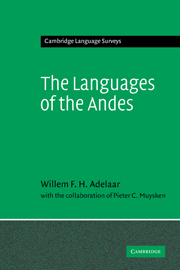Book contents
- Frontmatter
- Contents
- List of tables
- List of maps
- Preface
- Orthographic conventions
- List of abbreviations
- 1 Introduction
- 2 The Chibcha Sphere
- 3 The Inca Sphere
- 4 The languages of the eastern slopes
- 5 The Araucanian Sphere
- 6 The languages of Tierra del Fuego
- 7 The Spanish presence
- Appendix: Inventory of languages and language families of the Andean region
- References
- Author index
- Index of languages and ethnic groups
- Subject index
4 - The languages of the eastern slopes
Published online by Cambridge University Press: 22 September 2009
- Frontmatter
- Contents
- List of tables
- List of maps
- Preface
- Orthographic conventions
- List of abbreviations
- 1 Introduction
- 2 The Chibcha Sphere
- 3 The Inca Sphere
- 4 The languages of the eastern slopes
- 5 The Araucanian Sphere
- 6 The languages of Tierra del Fuego
- 7 The Spanish presence
- Appendix: Inventory of languages and language families of the Andean region
- References
- Author index
- Index of languages and ethnic groups
- Subject index
Summary
As the alter ego of Mario Vargas Llosa strolls through Florence, trying to put all matters Peruvian out of his mind in order to read Machiavelli and Dante, he stumbles onto an exhibit of dusty photographs of the Machiguenga. In El hablador (The Speaker; 1987), documentary and novel, this nation plays a central role, one of the countless groups of Indians struggling in small bands on the eastern foothills of the Andes and on the Amazonian plains, in order to maintain their cultural and linguistic integrity. This chapter will try to give a necessarily brief account of the very diverse languages of these groups.
Since it is impossible to say precisely where the slopes and foothills end and where the plains begin, we artificially delimit the area discussed in this chapter as the republics of Ecuador, Peru and Bolivia east of the Andes. The Chaco area of southeastern Bolivia extends into western Paraguay and into northwestern Argentina, and these are included as well. The Chaco languages are not covered by Dixon and Aikhenvald (1999). For these reasons, we include some material on all of the Chaco languages, even though they merit a more extensive separate treatment. Strictly speaking, this means that too many languages are included: languages of the Amazonian plains cannot properly be called Andean. On the other hand, it turns out that Quechua influence, one of the topics we will be concerned with in this chapter, extends far beyond the foothills.
- Type
- Chapter
- Information
- The Languages of the Andes , pp. 411 - 501Publisher: Cambridge University PressPrint publication year: 2004

